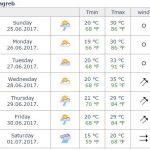According to the latest forecasts of the National Meteorological and Hydrological Institute, Croatia will see the worst heatwave of the year this week.
While the afternoon hours may see a chance of clouds, rain and thunderstorms in Croatia’s interior on Sunday, from Monday rainfall is likely to decrease, and high temperatures will only increase in the afternoons, reports Slobodna Dalmacija on July 30, 2017. This predominantly sunny and very hot forecast will last every day of the week until next weekend, if not further.
From Wednesday, a large part of the country will be marked as red on the heat index, meaning heat stroke is highly likely. According to current indicators, the worst hell is expected next Saturday when temperatures in a good part of Croatia, including Zagreb, Osijek, Slavonski Brod and other cities, will exceed 40 degrees Celsius.
Karlovac especially, which is expected to be 42 degrees Celsius in the shade according to current forecasts, will have the highest temperature in the country.
However, less extreme heat can be found in the south. Dubrovnik, for example, is not expected to exceed values well above 30 degrees Celsius, while Split should not see temperatures warmer than 35 degrees Celsius. It should be around 30 degrees Celsius on the Istrian coast and Kvarner region.
Here are some recommendations from the Croatian Institute of Public Health to help you survive the upcoming heatwave. Listen carefully.
Keep the space where you live cool. IIdeally, room temperatures should be kept below 32 degrees Celsius during the day and 24 degrees Celsius at night. This is especially important for children, people over the age of 60, or people with chronic health problems.
Drink still or mineral water and low-calorie beverages without caffeine, alcohol and sugar. It is advisable not to drink heavily chilled drinks.
Dehydration from the heat can be avoided by using diluted juice such as lemonade every 1-2 hours. Children should have one to two tablespoons or a sip of water every 15-20 minutes. Do not wait to until you feel thirsty to increase your fluid intake, especially in older people with weaker thirst.
Avoid staying in the sun from 10:00 to 17:00, this is especially for children, pregnant women, older adults, heart patients and those with chronic illnesses (mental illness, diabetes, etc.)
Shower or bathe in lukewarm water. Another option would be to wrap yourselves in cold and wet towels or a cool, wet sponge, a footpath, etc. Children can put wet towels on their hands and feet.
Wear lightweight clothing of natural materials. If you are going outdoors, wear a hat and sunglasses, and use umbrellas and fans to protect you from direct sunlight.
Use lightweight linens to avoid the accumulation of heat from the body.
Eat small meals often. Avoid protein-rich food. Prepare smoothies of fresh fruit or a light soup to help you regain any lost minerals, vitamins and electrolytes.
Regularly use protective agents against harmful UV radiation. Newborn infants and young children are especially vulnerable. Choose SPF with the highest factor (over 30) and wear lightweight clothing that also protects against UV rays.
Reduce the amount of hot air inside your apartment or home. Close the windows and lower the blinds, especially those facing the sun. Turn off all artificial lights and as many electrical appliances as possible in your home.
If you have an air conditioner, close the doors and windows to avoid using more energy than needed. Adjust the temperature, so it is not less than 7˚C from the outside.
Electric fans can provide relief and refreshment, but if the air temperature is above 35 ° C, it will not prevent any heat-related problems. It will, however, help circulate the air in the evenings.
If you have dizziness, weakness, anxiety or you are extremely thirsty and have a headache, ask for help as soon as you can and go to a cool space to have your temperature read.
Translated from Slobodna Dalmacija








